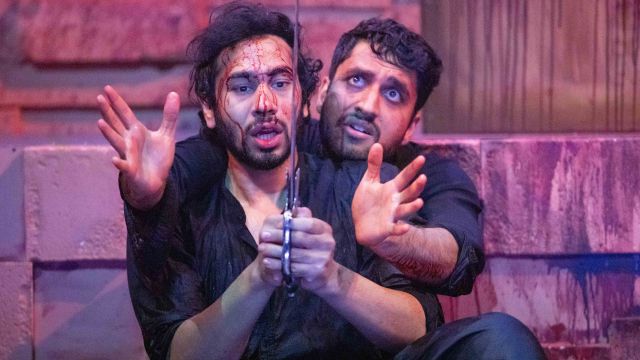Guards at the Taj
It is 1653 and the Taj Mahal is about to be revealed to the people. Years of speculation have almost immortalised the building, despite the fact that it has been hidden behind by a high wall. Humayun and Babur are two low level guards, stationed outside the wall to ensure secrecy until all is revealed at sunrise. They must not face the wall. They are not supposed to move or to speak. Their swords must be raised at all times. Disobedience will result in terrible punishment, including death by elephant.
Such are the ordeals faced by … the Guards at the Taj.
Guards at the Taj won the OBIE for Best New American play in 2016. Playwright Rajiv Joseph uses some of the myths that have embellished the construction of the ‘Taj’ to recall the vast differences in Indian society in the 1600s – the incredible wealth of the ruling class, the power they held over the people, and the cruelty practised by some of them.

One such was the Mughhal emperor, Shah Jahan, who commissioned the building of the Taj Mahal in 1632 as the tomb for his favourite wife, Mumtaz Mahal. The impressive white building, with its high domes and pillars, was designed by Ustad Ahmad Lahauriit. It took 20 years to complete – and the labour of 20,000 workers. Joseph uses those workers – and the guards – to recall, graphically, the accepted inequality and brutal practices of the time.
Fortunately, he uses humour to counterpoise the horror – and director Bali Padda and his cast incorporate that humour very effectively, especially in the opening scene.
Imagine a towering, blue lit, cutwork wall reaching high and wide across the front of a stage. Imagine a guard, resplendent in shimmering white and midnight blue uniform, complete with blue and silver turban and juttis, standing, sword held in his right hand outside the wall. This is Humayun, played by New Zealand born actor Idam Sondi. He is still, silent, face immobile. All is quiet – then Babur (Akkshey Caplash) rushes in and stands beside him. He’s late! He raises his sword. Humayun turns to look at him. “Wrong hand!” he hisses out of the side of his mouth. And the tension is broken!

Babur continues to break the solemnity – and danger – of their task. He is curious about the dawn birdsong. He reminisces about a tree house they built when they were boys. He wonders about the stars and imagines an ‘airo-plat’ that could take them to the stars. Caplash makes this character lovably curious and ingenuous. He fidgets, smiles, looks wide-eyed as he wonders.
Humayun tries desperately hard to maintain his position and stature, but is constantly taken “off guard” by the inquisitive restlessness of his friend. Even his dire warnings of the punishments they could receive for various misdemeanours are ignored. Sond sustains the strength of his initial moments on the stage. He gives a little, but never too much. He is ever aware of being caught out and his fear of punishment remains a constant in his reactions and expression.
That fear is shown especially clearly when he explains a situation that is concerning him. He has heard that the architect has asked the Shah if the 20,000 workers who have toiled so faithfully could be taken on a tour of the completed building. The Shah has reacted violently to such a monstrous suggestion – and promised an awful punishment.
Unfortunately, Babur and Humayun are chosen to carry out that cruel, inhumane punishment.

The second scene finds them in the bloody aftermath. In a brick cell, awash with blood, they relive what they have done. Gone is most of the humour. Though there are some moments of repartee, this scene, and one that comes later in the play, are fairly gruesome. Be warned!
Caplash and Sondi make the transitions between ‘guard’ and ‘butcher’ well. One moment they are rigid and resplendent in silk uniforms, next moment washing a bloody floor with a sodden towel. They aren’t easy transitions – and the costume changes make the scene changes a little long despite effective music and the play of light on the screen.
Set designer James Browne knows the Lennox Theatre stage, and makes good use of its proximity to the audience in the “guards” scenes – and the possibilities of what can be hidden behind a carefully lit, cutwork screen. The brick walled ‘cell’ in the second scene, with its sunken bath filled with murky water, is a surprise!

Kate Baldwin’s creative lighting mixed elegance outside the wall with pervading dankness behind it – and Me-Lee Hay enhanced this with sound and music that skilfully matched the changing atmospheres.
Though the play is set long ago in India’s past, it rekindles the class structure that dogged the sub-continent for so long … and prevailed, still, under British rule. It recalls the cruelty practised by many in authority, not just in India, and not only in the distant past.
Bali Pada and his very talented cast and crew have made Rajiv Joseph messages clear – and done so in a production that is very carefully envisioned.
Carol Wimmer
Photographer: Noni Carroll
Subscribe to our E-Newsletter, buy our latest print edition or find a Performing Arts book at Book Nook.

